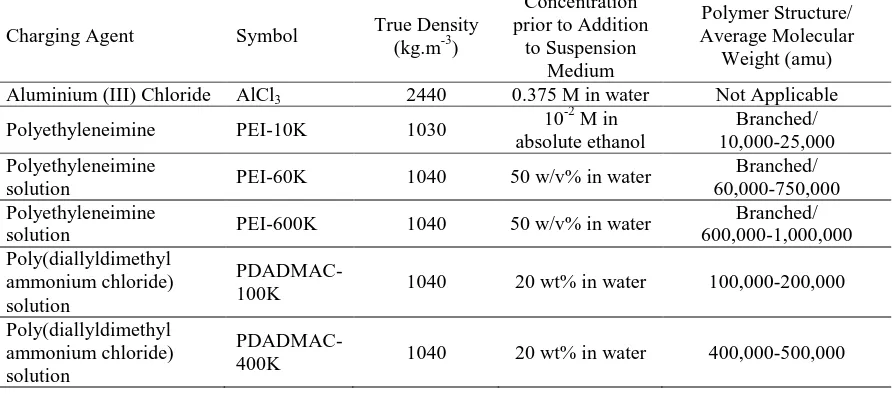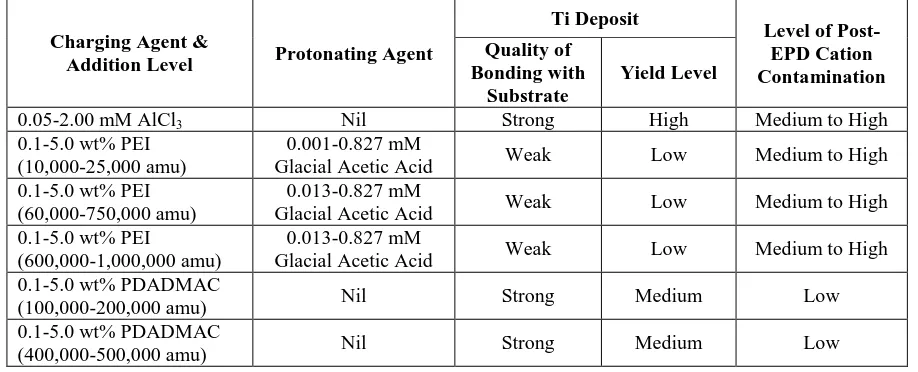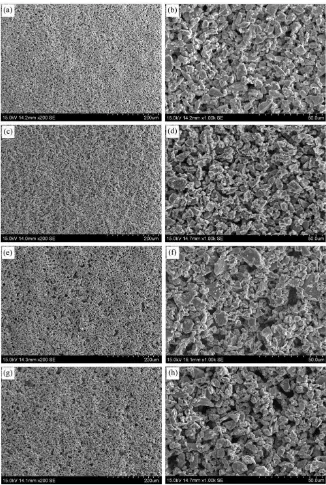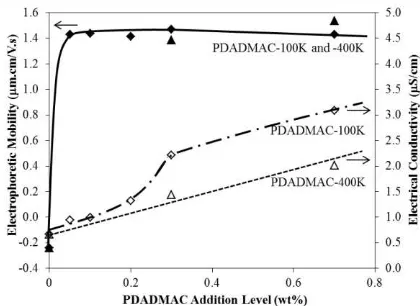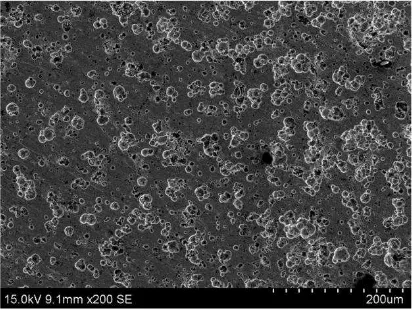Effect of Charging Agents on Electrophoretic Deposition
of Coarse Titanium Particles
Kok-Tee Lau
1,2*and C.C. Sorrell
11) School of Materials Science and Engineering, The University of New South Wales, Sydney, NSW 2052 Australia
2) Now at Faculty of Manufacturing Engineering, Universiti Teknikal Malaysia Melaka, Hang Tuah Jaya, 76100 Durian Tunggal, Melaka, Malaysia
Email: [email protected]
Available at: www.austceram.com/ACS-Journal
Abstract
The effects of aluminium (III) chloride (AlCl3), polyethyleneimine (PEI), and poly(diallyldimethylammonium
chloride) (PDADMAC)] as charging agents on the electrophoretic deposition (EPD) of coarse (≤20 μm) titanium (Ti) particles onto low-carbon steel cathodic substrates were assessed through microstructural evaluation, deposit yield, electrophoretic mobility measurements, and electrolytic corrosion. Apart from the capacity to achieve high bonding strength and yield, PDADMAC resulted in lower electrolytic corrosion of the cathode and introduced less anionic contamination than AlCl3 or PEI. The quality of the EPD deposit in terms of its bonding
strength and deposit yield depended on the length scale of the charging agents used in addition to the intrinsic nature of the charging agent (ionic functional groups and sites). Minimisation of the PDADMAC addition level and PDADMAC of lower molecular weight are advantageous for surface hardening purposes owing to lower the carbon content introduced into the deposit yield.
Keywords: Titanium, Steel, Polyelectrolyte, Electrophoresis
1. Introduction
Electrophoretic deposition (EPD) as an alternative coating technique for various applications is of interest mainly owing to the simple equipment requirements, excellent control of the coating parameters, and achievement of controlled coating thicknesses on both simple and complex shapes1-4. However, the EPD technique rarely is considered as an alternative to currently available surface hardening methods because the deposited coating have relatively poor mechanical properties and bonding strengths to the substrate 1,4. Nevertheless, a combination of this method with subsequent heat treatment is capable of increasing the bulk density, strength, and coherence of the EPD coating for the purpose of corrosion protection4,5. The present work also demonstrates that it is possible to obtain good adhesion at the coating/substrate interface, thereby suggesting that atomic diffusion occurs in the coating/substrate interface region during heat treatment.
The present work explores the deposition of Ti particles by EPD for the application of a surface hardened layer on low-carbon steel. While titanium (Ti) metal in particulate form is used mostly in the powder metallurgy of Ti-based alloys, Ti also is
used in many other applications owing to its low true density, high strength, high ductility, and high corrosion resistance6,7. It also is used as a precursor to form hard titanium-based ceramics, such as titanium nitride (TiN) and titanium carbide (TiC)7. It is considered that a Ti deposit (coating) applied on low-carbon steel by EPD could serve as a controllable layer and Ti reservoir for the formation of abrasive Ti-based hard surfaces. This could involve either (a) deposition of Ti particles following by reaction bonding under a reactive gas such as N2 or CH4 or (b) formation of a Ti-rich
surface diffusion layer followed by surface reaction with a reactive gas.
The EPD of relatively coarse and non-colloidal Ti particles requires the use of a charging agent in order to provide additional surface charge for the stabilisation of the suspended particles and the electrophoretic mobility during the deposition process. Further, these charging agents act as binders to improve the green adhesion between deposited particles and substrate1,4 The most commonly used charging agents for the EPD of metallic particles are aluminium chloride (AlCl3)5,8,
poly(diallyl-Lau et al. 109
dimethylammonium chloride) (PDADMAC)11,12. Although the effect of these individual charging agents has been studied extensively, direct comparison of the effects of these charging agents on the EPD of Ti particles has not been reported. Coarse Ti particles (particle size = 1-50 µm) were used in the current study owing to the advantage of the lower volume of the inevitably present surface oxide. Although these particles are non-colloidal and so have relatively low surface charge, they can be deposited and controlled during EPD with the use of a cationic charging agent and suitable EPD parameters11. The present work used ethanol as suspension medium instead of water in order to avoid detrimental hydrogen permeation into working electrode13 and so minimise electrolysis and electrolytic corrosion of the low-carbon steel cathode. Stainless steel was used as the counter-electrode (anode) in the EPD set-up instead of a precious metal, such as palladium or platinum, owing to its lower cost.
The aim of the present work was to investigate and compare the effects of the three charging agents on the EPD of coarse Ti particles. The effects on the EPD were compared in terms of the following criteria: (a) the bonding strength and yield of the Ti deposit, (b) the electrophoretic mobility of the Ti absolute ethanol (99.7 wt%, CSR Ltd., Australia) to give a solids loading of 5 mg.mL-1. First, Ti particles were added to the suspension medium and then gently magnetically stirred for 1 min using a Teflon-coated bar of 2 cm length in a 25 mL Pyrex beaker. Second, a small amount of a selected charging agent (0.1-0.7 wt%, Ti particle weight basis) was added using a pipette, followed by gentle magnetic stirring for 30 min at the same stirring speed. The temperature of the suspension was maintained at ~25oC throughout the preparation process. In order to study the effect of cationic charging agent on the EPD, several suspensions of Ti particles were prepared with different cationic charging agents, the details of which are given in function effectively as a cationic charging agent for the deposition of coarse non-colloidal particles15. Table 1. Details of the charging agents used for the EPD of Ti particles (all of the chemicals were reagent-grade and were supplied by Sigma -Aldrich Co., Australia)
Charging Agent Symbol True Density
(kg.m-3) Aluminium (III) Chloride AlCl3 2440 0.375 M in water Not Applicable
Polyethyleneimine PEI-10K 1030 10
-2
Microstructure: The particle and deposit
morphologies as well as the general appearance of the deposits were assessed by scanning electron microscopy (SEM, 15 kV accelerating voltage, secondary electron emission mode, S3400N, Hitachi High-Technologies Corporation, Japan). The samples did not require preliminary coating since they were metallic.
Electrophoretic Mobility and Electrical
Instruments Co., USA). The use of the low electric field of ~10 V.cm-1 was to avoid thermal vibrations deriving from the use of high electric fields, which would reduce the signal-to-noise ratio of the ZetaPALS measurements (the detection sensitivity of the ZetaPALS unit is high at low fields16). EPD Set-Up: The working electrode (cathode) or substrate consisted of SAE 1006 grade low-carbon steel with submerged dimensions 10 mm H x 5 mm W x 0.55 mm T. The counter-electrode (anode) consisted of 304 grade stainless steel with submerged dimensions of 10 mm H x 10 mm W x 1.5 mm T (both BlueScope Steel Ltd., Australia). The low-carbon steel substrates were hand-polished to P320 grit SiC paper (46.2 µm particle size), ultrasonically cleaned in absolute ethanol, and air-dried before deposition; all samples were used within ~30 min of drying. The circuit consisted of mutually parallel electrodes at a fixed separation, connected by alligator clips to a d.c. programmable power supply (EC2000P, E-C Apparatus Corp., sedimentation was apparent immediately following mixing, each suspension was magnetically stirred for ~1 min following lowering of the electrodes into the suspension. After this, the voltage was applied. Each sample was removed from the suspension slowly at a constant pulling rate of 0.2 mm.s-1 immediately after EPD ended. The weight gain was determined after EPD for each cathode by air drying for ~30 min and weighing at 0.00001 g precision (BT25S, Sartorius AG, Germany).
3. Results and Discussion
Table 2 qualitatively summarises the outcomes of the EPD using the cationic charging agents.
Bonding Strength of the EPD Deposit:
High bonding strengths (Ti particle-Ti particle and Ti deposit-steel substrate) were obtained with AlCl3, PDADMAC-100K, and PDADMAC-400K.
Table 2. Parameters and outcomes of the EPD of Ti particles using different cationic charging agents
Charging Agent &
Addition Level Protonating Agent
Ti Deposit
Glacial Acetic Acid Weak Low Medium to High
0.1-5.0 wt% PEI (60,000-750,000 amu)
0.013-0.827 mM
Glacial Acetic Acid Weak Low Medium to High
0.1-5.0 wt% PEI
(600,000-1,000,000 amu)
0.013-0.827 mM
Glacial Acetic Acid Weak Low Medium to High
0.1-5.0 wt% PDADMAC
(100,000-200,000 amu) Nil Strong Medium Low
0.1-5.0 wt% PDADMAC
(400,000-500,000 amu) Nil Strong Medium Low
This was demonstrated by the good green adhesion to the substrate observed during removal (vertical lift) of the coated cathode from the suspension. A comparatively weaker green bonding strength was obtained when PEI-10K was used. This was indicated by the gradual particle dislodgement from the deposit, which began to occur immediately after the cessation of the electric field and upon removal of the cathode. Also, the use of PEIs of higher average molecular weights (60K and PEI-600K) resulted in ready particle dislodgement. The variation in bonding strengths of the deposits using different charging agents is confirmed by their respective microstructures, as shown in Figure 1. AlCl3 gave a smooth deposit surface, thus
indicating a high bonding strength and negligible
particle dislodgement. Although the PDADMACs also gave relatively smooth surfaces, randomly distributed micro-cavities of size 10-20 μm) were observed throughout, presumably caused by the dislodgement of larger particles. It is likely that this dislodgement was caused by the dominance of gravity and suspension’s adhesive force over the weaker van der Waals inter-particle bonding. The low bonding strength of the PEIs is illustrated by the loosely packed, rough, and wavy coverage, suggesting severe particle dislodgement irrespective of the size of the deposited particles. On the basis of a qualitative comparison of particle dislodgement from deposits produced using different charging agents, the sequential order of charging agent in terms of the corresponding bonding strength is AlCl3 > PDADMAC-100K > PDADMAC-400K >
Lau et al. 111
Figure 1. SEM micrographs of the Ti deposits prepared using different charging agents. (a) and (b): 0.3 mM AlCl3; (c) and (d): 2.0 wt% PEI-10K (average molecular weight = 10,000-25,000 amu) mixed with 0.013 mM
acetic acid and absolute ethanol as medium; (e) and (f): 0.3 wt% PDADMAC-100K (average molecular weight = 100,000-200,000 amu); (g) and (h): 0.3 wt% PDADMAC-400K (average molecular weight = 400,000-500,000 amu). (a), (c), (e), and (g): 200 magnification; (b), (d), (f), and (h): 1000 magnification
EPD Deposit Yield and Electrophoretic
Mobility:
The deposit yields from EPD using AlCl3,
PDADMAC-100K, and PDADMAC-400K as a function of addition level (from 0 to 0.07 wt%) are shown in Figures 2 and 3. All of the data show the same general trends: (a) at lower addition levels, the respective deposit yields show a rapid logarithmic increase until reaching a maximum, and (b) this trend was followed by a slower logarithmic decline as the addition levels of the charging agents exceeded the optimal saturation levels. Previous work1,4 has shown that the EPD deposit yield is
governed by the electrophoretic mobility of suspension particles before deposition and the deposition efficiency of the particles on the electrode (viz., the mass ratio [number particles attached to the electrode after EPD]/[total number of particles reaching the electrode during EPD]). Thus, the electrophoretic mobilities of the Ti with AlCl3 or PDADMAC were determined, as shown in
Lau et al. 111
Figure 2. Dependence of the deposit yields on the AlCl3 addition levels
Figure 3. Dependence of the deposit yields on the addition levels of PDADMAC with average molecular weight of 100,000-200,000 amu and 400,000-500,000 amu
Figure 4. Electrophoretic mobilities of Ti particles and electrical conductivities of suspension as a function of AlCl3 addition level
The deposit yield and electrophoretic mobility measurement for the PEI additions was not done owing to inconsistencies deriving from severe particle dislodgment after the EPD.
A more detailed assessment of the deposit yield profile allows the following conclusions to be made:
Figure 5. Electrophoretic mobilities of Ti particles and electrical conductivities of as a function of addition levels of PDADMAC with average molecular weight of 100,000-200,000 amu and 400,000-500,000 amu); curve fitting for the electrophoretic mobility of the latter PDADMAC addition was not done owing to data limitations (a) A relatively rapid increase in deposit yield versus addition level of charging agent, as shown in Figures 2 and 3, reflects the saturation of the Ti particle surfaces by the charging agent at a relatively low level (i.e., AlCl3 – 0.3 mM;
PDADMAC-100K and PDADMAC-400K – 0.3 wt% on Ti mass basis [equal to 7.5 x 10-5 mM]). This conclusion is supported by the similar increase of the corresponding electrophoretic mobilities of the Ti particles, as shown in Figure 4.
(b) The maximal deposit yields, as shown in Figures 2 and 3, supported by the maximal electrophoretic mobility at the same addition level, as shown in Figure 4, represent a threshold between the Ti surface area and the amount of charging agent necessary to saturate it before deposition. It is considered that this maximum is independent of the applied electric field but entirely dependent on the interplay between the deposited particle’s surface area, the packing characteristics, and the conformation of the adsorbed charging agents on the uneven Ti surface.
(c) The slow decline in the deposit yield at higher levels of charging agent can be explained by two divergent scenarios:
optimal addition level, the lesser rates of decline of the electrophoretic mobilities relative to those of the deposit yields is attributed to the additive effect of free (excess) charging agent molecules on the electrophoretic mobilities.
ii. Electrode Effect (Growth of Interposing Charging Agent-Rich Layer): With increasing amounts of excess charging agents, a greater proportion of them would be deposited. These charging agents would interpose between the depositing cathode surface and the Ti particles, thereby reducing the adhesion between the low-carbon steel cathode and the Ti particles. This is because the negatively charged oxide layers on the metals can be assumed to be better bridged by a single charging agent ion or molecule compared to a thicker interposing charging agent-rich layer. The interposing charging agent would contribute to a reduction in the adhesion and hence increase the particle dislodgement. Further, the insulating layer of the charging agent would weaken the electric field and indirectly would reduce the rate of particle deposition.
The variation in the deposit yield profiles using AlCl3, PDADMAC-100K, and PDADMAC-400K,
as shown in Figures 2 and 3, can be explained as follows:
i. Optimal Addition Level of Char ging Agent (Saturation Limit): The maximal deposit yields of the suspensions with AlCl3 were
obtained at the optimal addition level (0.3 mM), which is higher than the optimal levels for PDADMAC-100K and PDADMAC-400K, both of which were achieved at 7.5 x 10-5 mM. That the former had a higher optimal addition level may be due to the more ordered adsorption configuration of the Al3+ ions compared to that of the long and branched PDADMAC molecules on the uneven surface of the Ti particles. The former would have yielded a higher surface charge density and so a considerably higher molarity (viz., addition level) of Al3+ was required for saturation coverage of the Ti particles.
ii. Deposit Yield: The deposit yields of suspensions with AlCl3 were comparatively
higher than those with PDADMAC-100K and PDADMAC-400K. For example, the maximal deposit yield with AlCl3 was 14.44
mg.cm-3 when the addition level was at 0.3 mM, which may be compared to the same data for suspensions with PDADMAC-100K and PDADMAC-400K, which gave maximal deposit yields of 2.72 and 2.58 mg.cm-3, respectively when the addition level was at
only 7.5 x 10-5 mM. That different maximal deposit yields were observed suggests variation in the degree of saturation coverage of the uneven Ti particles with these charging agents. However, no significant difference was observed in their corresponding maximal electrophoretic mobilities (~1.4 µ m.cm.V-1.s-1) since the electrophoretic mobility correlates with the total amount of charge adsorbed on the Ti particles. It is presumed that a lower surface charge density of the PDADMAC-adsorbed Ti particles (compared to that of the Al3+-adsorbed Ti particles) resulted in weaker bonding strength and decreased rate of deposition. At addition levels higher than optimal, excess charging agent would be deposited between the Ti particles. Owing to the large polymeric size of the interposing PDADMAC molecules (compared to that of the small interposing Al3+ ions), greater particle dislodgement and/or electric field shielding effect would have resulted in lower deposit yields with the former. The lengths of the charging agent molecules also would be expected affect the deposit yields. Hence, the shorter PDADMAC-100K gave a slightly higher deposit yield (compared to that of the longer PDADMAC-400K.
iii. Deposit Yield Curve: Deposit yield of PDADMAC-400K gave parabolic graph as compared to the yield of AlCl3 and/or
PDADMAC-100K which displayed skewed graphs. The parabolic feature of the former implies slower increase of electrophorectic mobilities of PDADMAC-400K-adsorbed Ti particles. This may be resulted from the slower adsorption of large molecular weight of the PDADMAC-400K onto the Ti particles as compared to the smaller PDADMAC-100K and Al3+.
iv. Electrical Conductivity of Suspension: The apparent inflections in the electrical conductivity of the suspensions with AlCl3
(smaller scale) and PDADMAC-100K (larger scale) can be seen at addition levels of ≤0.3 wt%. It would be expected that the conductivity would increase in direct proportion to the amount of free chloride ions deriving from the dissociation of the AlCl3 or
Lau et al. 113
in the electrical conductivity at the optimal addition level. This observation suggests that chloride ions were attracted to the positive PDADMAC-400K-adsorbed Ti particles but, owing to the greater length of the PDADMAC-400K molecules, the attracted chloride ions on the positive functional sites were dispersed further away from the nearby chloride ions, thus negating the localisation effect of the chloride ions.
Post-EPD Cation Contamination:
Electrolytic corrosion of the 304 grade stainless steel anode occurred during the EPD process with all charging agents used in the suspensions. The conclusion that electrolytic corrosion occurred is supported by the following observations:
(a) The EPD suspension became progressively brownish in colour with increasing EPD time. The brownish contaminant is assumed to be iron (III) (Fe3+) ions, which were released after the electrolytic corrosion of the steel surface.
(b) The steel anode’s surface was converted from a metallic lustre to a greyish and dull colour.
(c) Severe pitting corrosion located randomly across the anode surface was observed, as shown in Figure 6.
Figure 6. Pitting corrosion observed on the surface of 304 grade stainless steel anode after repeated EPD
It is assumed that electrolytic corrosion was caused by the establishment of a galvanic couple when a potential difference was applied across the anode-cathode couple immersed in a suspension with a significant amount of electrolyte17. It was observed that EPD using PEI and AlCl3 produced darker
brown-coloured post-EPD suspensions, as suggested in Table 2, owing to the higher anion concentrations (originating from Cl− from AlCl3
and CH3COO− from glacial acetic acid and OH−
from water with PEI) relative to less brownish suspensions when PDADMAC, with a lower Cl− content was used.
The cation contamination in the suspension released by the electrolytic corrosion is undesirable owing to increased deposition of unwanted cation contaminants in the deposit and increased suppression of the double layer of charged Ti particles resulting from the increase in the electrical conductivity of suspension.
4. Summary and Conclusions
The effects of four different charging agents (i.e., aluminium (III) chloride (AlCl3), polyethyleneimine
(PEI), and poly(diallyldimethylammonium chloride) (PDADMAC)) on the EPD of coarse Ti particles suspended in absolute ethanol were assessed in terms of (a) bonding strengths, deposit yields, and planar surface microstructure of the Ti deposits; (b) electrophoretic mobilities of the Ti particles; (c) electrical conductivities of the suspensions; and (d) colours of the post-EPD suspensions.
EPD using AlCl3 produced deposits with high
bonding strengths and high deposit yields. However, the presence of the electrolyte in the EPD suspension contributed to severe electrolytic corrosion of the anode, which led to cationic contamination introduced into the suspension and deposit. While PDADMAC resulted in comparatively lower bonding strengths and deposit yields compared to the addition of AlCl3, the
induced corrosion and contamination caused by PDADMAC was less than those from AlCl3. In
contrast, the deposits formed with the addition of PEI revealed significantly greater particle dislodgement compared to that for suspensions with AlCl3 and PDAMDAC. The serious particle
dislodgement resulted in lower and inconsistent deposit yields for these samples. The usage of a protonating agent with the PEI also induced high electrolytic corrosion and contamination.
It is likely that higher bonding strengths and deposit yields result from higher surface charge densities of charging agent-adsorbed Ti particles. While the intrinsic nature of the charging agent (in terms of the functional groups and sites) is important, the surface charge density was found to be inversely proportional to the length of the charging agent species.
However, the higher degrees of electrolytic corrosion caused by the use of AlCl3 and PEI were
attributed to the anion concentrations introduced by adding the charging agents to the suspensions. It is concluded that PDADMAC charging agents are superior to those based on AlCl3 or PEIs (at
the PDADMAC addition level and the use of PDADMAC of a lower molecular weight suitable areas for future investigation because reduced organic levels with lower the amount of carbon residue left following EPD.
Acknowledgements
The authors would like to thank the Universiti Teknikal Malaysia Melaka (UTeM) and the Ministry of Higher Education, Malaysia for financial support for this work.
5. References
1. Besra, L, Liu, M, "A Review on Fundamentals and Applications of Electrophoretic Deposition (EPD)". Prog. Mater. Sci., Vol. 52, (1), (2007), 1-61.
2. Corni, I, Ryan, MP, Boccaccini, AR, "Electrophoretic Deposition: From Traditional Ceramics to Nanotechnology". J. Eur. Ceram. Soc., Vol. 28, (7), (2008), 1353-1367.
3. Vilarinho, PM, Fu, Z, Wu, A, Kingon, AI, "Critical Role of Suspension Media in Electrophoretic Deposition: The Example of Low Loss Dielectric BaNd2Ti5O14 Thick Films".
J. Phys. Chem. B, Vol. 117, (6), (2012), 1670-1679.
4. De Riccardis, MF, "Ceramic Coatings Obtained by Electrophoretic Deposition: Fundamentals, Models, Post-Deposition Processes and Applications”, Chapter 2 (pp. 43-68) in Ceramic Coatings - Applications in Engineering, Shi, F (ed.), InTech, Rikika, Croatia (2012).
5. Hashaikeh, R, Szpunar, JA, "Electrophoretic Fabrication of Thermal Barrier Coatings". J. Coat. Technol. Res., Vol. 8, (2), (2011), 161-169.
6. Hussain, T, "Cold Spraying of Titanium: A Review of Bonding Mechanisms, Microstructure and Properties". Key Eng. Mater., Vol. 533, (2013), 53-90.
7. Lütjering, G, Williams, JC, Titanium, Springer-Verlag, Berlin (2003).
8. Benehkohal, NP, Demopoulos, G, "Green Preparation of TiO2-ZnO Nanocomposite
Photoanodes by Aqueous Electrophoretic Deposition". J. Electrochem. Soc., Vol. 159, (5), (2012), B602-B610.
9. Neirinck, B, Mattheys, T, Braem, A, Fransaer, J, Van der Biest, O, Vleugels, J, "Porous Titanium Coatings Obtained by Electrophoretic Deposition (EPD) of Pickering Emulsions and Microwave Sintering". Adv. Eng. Mater., Vol. 10, (3), (2008), 246-249.
10. Uchikoshi, T, Suzuki, TS, Sakka, Y, "Orientation Control of Hematite via Transformation of Textured Goethite Prepared by EPD in a Strong Magnetic Field." Key Eng. Mater., Vol. 507, (2012), 227-231.
11. Moreno, R, Ferrari, B, "Nanoparticles Dispersion and the Effect of Related Parameters in the EPD Kinetics." Chapter 2 (pp. 73-128) in Electrophoretic Deposition of Nanomaterials, Dickerson, JH and Boccaccini, AR (ed’s). Springer, New York (2012).
12. Kinzl, M, Reichmann, K, Andrejs, L, "Electrophoretic Deposition of Silver from Organic PDADMAC-Stabilized Suspensions". J. Mater. Sci., Vol. 44, (14), (2009), 3758-3763. 13. Iino, M, "Analysis of Irreversible Hydrogen
Trapping". Acta Metall., Vol. 32, (2), (1982), 377-383.
14. Lau, K-T, Sorrell, CC, "Electrophoretic Mobilities of Dissolved Polyelectrolyte Charging Agent and Suspended Non-Colloidal Titanium during Electrophoretic Deposition". Mater. Sci. Eng. B, Vol. 176, (2011), 369-381. 15. Tang, F, Uchikoshi, T, Ozawa, K, Sakka, Y,
"Effect of Polyethylenimine on the Dispersion and Electrophoretic Deposition of Nano-Sized Titania Aqueous Suspensions". J. Eur. Ceram. Soc., Vol. 26, (9), (2006), 1555-1560.
16. Anon., Instruction Manual for ZetaPALS, Zeta Potential Analyzer (accessed 15 February 2013), http://www.bic.com/ZetaPALS.html. 17. Silberberg, MS, Chemistry: The Molecular
